Introduction: The Rise of Robo-Taxis
Autonomous robo-taxis (self-driving taxis) rely heavily on Artificial Intelligence (AI) to navigate, make decisions, and interact with passengers. AI processes vast amounts of data from sensors (cameras, LiDAR, radar) to perceive the environment, predict movements and control the vehicle safely.
Before robo-taxis, transportation was riddled with issues like human error, unpredictable driver behavior, inconsistent ride quality, and the constant need for human attention. With urban populations surging and traffic fatalities increasing, there was a dire need for safer more efficient alternatives.
Robo-taxis are the answer to that call. These intelligent vehicles combine cutting-edge AI with real-time data analysis to transform mobility. Add audio technology to the mix, and the entire user experience becomes not just smarter, but safer and more comfortable.
Audio technology is no longer just about entertainment—it’s reshaping how we interact with vehicles. From voice-controlled commands that enhance convenience to external sound alerts that protect pedestrians, audio systems are playing a pivotal role in boosting both passenger engagement and road safety.
Getting into a self-driving car may soon feel as normal as calling a cab, with AI-powered robo-taxis reshaping mobility through voice commands, autonomous navigation, and seamless, everyday ride experiences worldwide—powered by the rise of Market Intelligence driving these innovations.
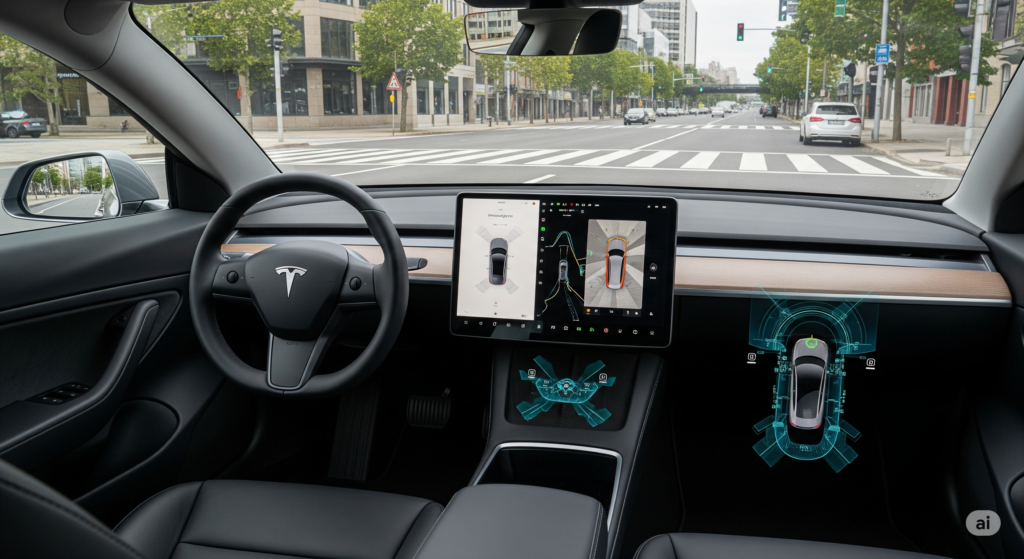
Will Robo-Taxis Replace Human Drivers?
They don’t need steering wheels, coffee breaks, or even a driver’s license. These autonomous, AI-powered vehicles are designed to navigate roads, detect traffic, and safely transport passengers—entirely without human intervention. Built with cutting-edge sensors, real-time data processing, and machine learning, robo-taxis are rewriting the rules of urban mobility, making transportation smarter, safer, and fully self-driven.
What Are Robo-Taxis?
Robo-taxis are autonomous, AI-driven vehicles that transport passengers without the need for a human driver. Unlike traditional taxis that require a licensed driver, robo-taxis operate through a combination of sensors, real-time analytics, and machine learning.
How They Differ from Regular Taxis
- Operate without human intervention
- Use AI algorithms for navigation and decision-making
- Can be requested via apps for 24/7 service
What Makes Robo-Taxis Unique?
- Driverless by Design: Navigate using AI algorithms, not human judgment
- Always Available: Book anytime—no downtime, no lunch breaks
- Smarter Navigation: Real-time data helps avoid traffic, optimize routes, and reduce travel time
- Eco-Friendly Models: Most use electric or hybrid systems to reduce carbon footprint
- Self-Learning Systems: Improve performance over time by learning from road conditions and passenger feedback
Key AI Technologies in Robo-Taxis
So, what exactly powers a robo-taxi to think, decide, and drive on its own? A quick technology landscape analysis reveals the key AI components working seamlessly together:
- Computer Vision: AI interprets data from cameras to detect pedestrians, vehicles, road signs, and lane markings.
- Sensor Fusion: Combines LiDAR, radar, ultrasonic, and camera data for a holistic understanding of surroundings.
- Path Planning & Decision-Making: Predicts safe, efficient routes while adapting to road conditions in real-time.
- Deep Learning & Neural Networks: Uses historical driving data to improve decision-making and reduce errors.
- Natural Language Processing (NLP): Enables voice-based interactions for smoother passenger control and experience.
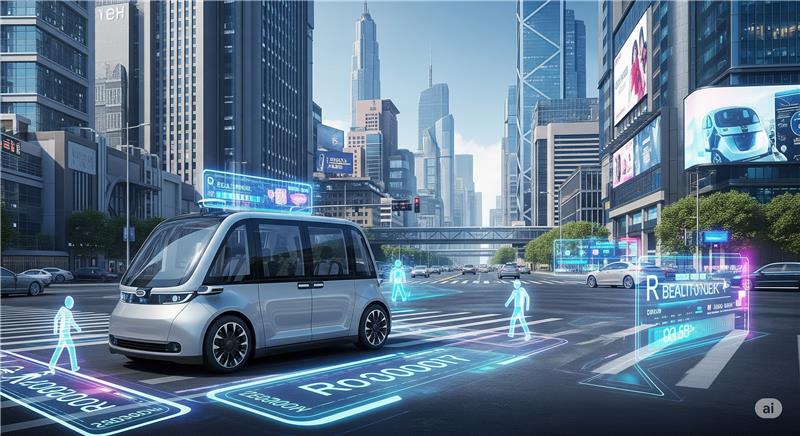
How Audio Technology Enhances Robo-Taxis
1. In-Cabin Voice Assistants & Passenger Interaction
Inside the robo-taxi, voice assistants allow passengers to control the ride hands-free—requesting destinations, updates, or even nearby stops.
- Voice Commands: Initiate and modify routes using voice commands (“Take me to the airport”).
- Conversational AI: Provides ride updates, Estimated Time of Arrival (ETA), and nearby place recommendations.
2. External Sound Alerts (AVAS)
These systems generate context-aware, directional sound cues that respond to movement, speed, and environment—ensuring safety while complying with AVAS (Acoustic Vehicle Alerting System) regulations.
AI-Controlled Acoustic Systems & Sensor-Triggered Sound Modules
- For Pedestrians: Generates artificial sounds to alert pedestrians at low speeds.
- Regulatory Compliance: Fulfills legal requirements in countries mandating AVAS for electric and autonomous vehicles.
3. Emergency Audio Warnings
Robo-taxis are equipped with AI that continuously listens for external warning sounds—like ambulances, fire trucks, or honking cars—and alerts passengers with timely, spatial cues.
AI-Powered Sound Recognition Systems & Directional Audio Mapping
These smart systems identify critical noises, determine their direction and urgency, then deliver real-time spatial warnings—ensuring the vehicle adapts or pulls over safely when needed.
- Detects sirens, horns, or potential threats and notifies passengers with spatial warnings.
4. Noise Cancellation & Enhanced Audio Experience
AI-tailored sound zones let passengers to enjoy music, calls, and podcasts without any overlap, making every journey peaceful, clear, and intimate.
- Active Noise Cancellation: Reduces external road and engine noise for a smoother ride.
- Personalized Audio Zones: Allows passengers to enjoy different audio streams without interference.
5. Sound-Based Diagnostics
Your robo-taxi can hear its own heartbeat. AI listens to internal sounds like clicks, squeaks, and vibrations to catch problems early—before they become dangerous or expensive.
AI Audio Recognition + Predictive Analytics
From faulty brakes to engine misfires, smart systems analyze acoustic patterns in real-time, ensuring maintenance is proactive, not reactive—keeping every ride smooth and safe.
Future Audio Innovations:
Audio technologies are entering a new field as robo-taxis develop, not only for communication but also for safety and personalization. A little peek at what’s to come:
- Biometric Voice Recognition: Tailors experience based on individual passenger voice.
- 3D Audio Alerts: Alerts from specific directions for enhanced safety.
- Emotion Detection: Adjusts lighting/music based on vocal emotion analysis.
Present Day Transportation Challenges
Despite rapid tech advancements, today’s transportation still faces major roadblocks. Below are key challenges—each one paving the way for future mobility innovations.
- Human error leading to road accidents
Driver misjudgments, distractions, or delayed responses contribute significantly to collisions, making safety a persistent concern in manually driven transportation systems. - Fatigue and distraction among drivers
Long hours on the road often lead to mental exhaustion or diverted attention, reducing awareness and increasing the risk of preventable accidents. - Limited 24/7 transportation availability
Late-night or early-morning commutes become difficult in many areas, as human-dependent systems can’t consistently offer round-the-clock ride availability. - Traffic congestion due to poor route optimization
Without real-time data analytics, drivers follow outdated paths or fixed routes, worsening congestion and causing delays during peak hours. - Inconsistent customer service experience
From pricing issues to driver behavior, human error leads to unpredictable passenger experiences, making ride-hailing less dependable for many users. - High operational costs for ride-hailing platforms
Manual fleet management, driver wages, fuel inefficiency, and unpredictable maintenance costs inflate overheads, reducing profitability and limiting scalability.
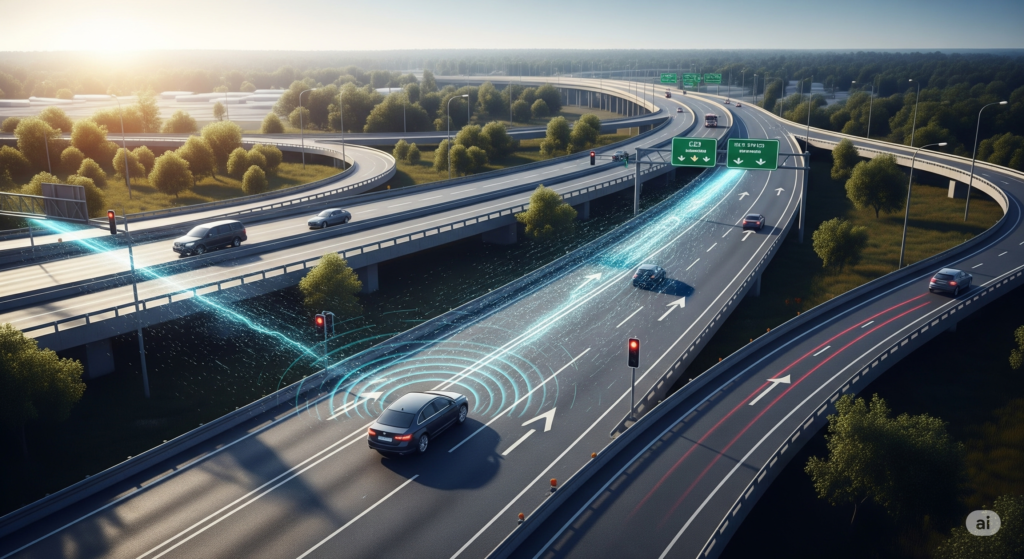
New-Age Innovations Are Changing the Face of Transportation in Automotive
Self-aware cars and smart streets are only two examples of the high-tech revolution taking place in the transportation sector. These developments are not merely futuristic; they are now taking place and altering our daily movements.
- AI-Powered Robo-Taxis for Effortless Travel
Robo-taxis use real-time AI algorithms to navigate traffic, avoid collisions, and understand voice commands—delivering safer, smoother, and more responsive rides without human intervention. - Vehicle-to-Everything (V2X) Communication Systems
Cars now talk to traffic lights, road signs, and even each other—helping prevent accidents, reduce congestion, and enable seamless communication across smart transportation networks. - Augmented Reality Dashboards and Navigation
AR-powered windshields overlay navigation cues, hazard alerts, and traffic data directly on the driver’s view—making decision-making faster, safer, and distraction-free. - Edge AI for Predictive Vehicle Diagnostics
Embedded processors analyze engine health, brake wear, and tire pressure in real-time—helping drivers avoid breakdowns and manage maintenance before issues arise. - Biometric Access and Personalized In-Cabin Experiences
From facial recognition to mood-responsive lighting and music, AI personalizes rides based on each passenger’s preferences, ensuring both comfort and security.
Robo-taxis are ushering in a future of smarter mobility. With AI’s predictive algorithms, vehicles can adapt to traffic in real-time, avoid obstacles, and even understand the natural human language.
These innovations promise to reduce commute times, cut down emissions, and redefine the way we think about car ownership. Through Technology Gap Analysis, companies can pinpoint what’s missing in their autonomous strategies—ensuring that stepping into a self-driving taxi soon feels more personalized, intelligent, and seamless than any ride before.
See how AI-powered robo-taxis stack up against conventional taxis below to see why the future of transport is coming sooner than we thought.
Comparison: Human-Driven vs. AI-Driven Vehicles
| Feature | Human-Driven Taxis | Robo-Taxis (Self-Driving) |
| Requires Driver | Yes | No |
| Operating Hours | Limited (based on shifts) | 24/7 |
| Error Rate | High (due to fatigue/distraction) | Low (AI monitored) |
| Cost of Operation | High (salary, insurance) | Lower (no driver cost) |
| Customer Experience | Varies | Consistent, personalized |
| Predictive Route Optimization | Manual | Real-time AI adjustments |
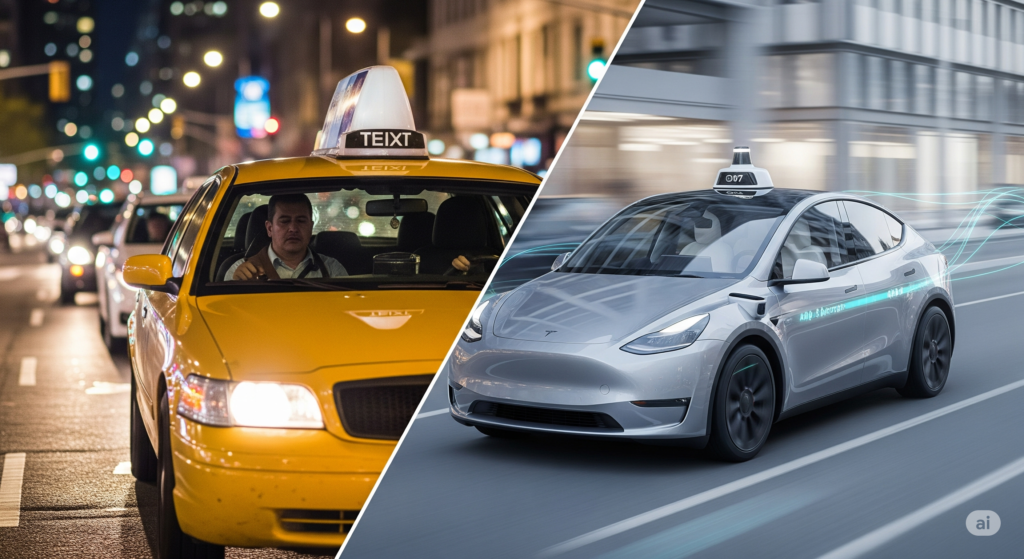
Benefits of Self-Driving Taxi Rides in the Digital Era
- 24/7 accessibility without dependence on human drivers
- Lower ride costs due to reduced labor and fuel expenses
- Increased road safety with fewer accidents
- Efficient fleet management
- Enhanced user comfort with audio tech and personalization
- Environmentally friendly when paired with EV tech
The Robo-Taxi Market Is Accelerating Toward an Autonomous Future
As urban mobility evolves, the market for Robo-Taxis is gaining unprecedented momentum—driven by the need for safer, driverless transportation, lower operational costs, and 24/7 accessibility. With congestion and emissions reaching critical levels, city planners, tech firms, and mobility providers are turning to AI-powered autonomous taxis as the next big leap in transport innovation.
According to Signicent’s Market Research, the global Robo-Taxi market is projected to expand at a CAGR of over 42% by 2030, powered by rapid advancements in computer vision, LiDAR, sensor fusion, and real-time path planning. As countries introduce AV-friendly regulations and demand rises for contactless, efficient rides, Robo-Taxis are poised to become a cornerstone of smart city ecosystems—delivering cost-effective, zero-emission, and personalized transport at scale.
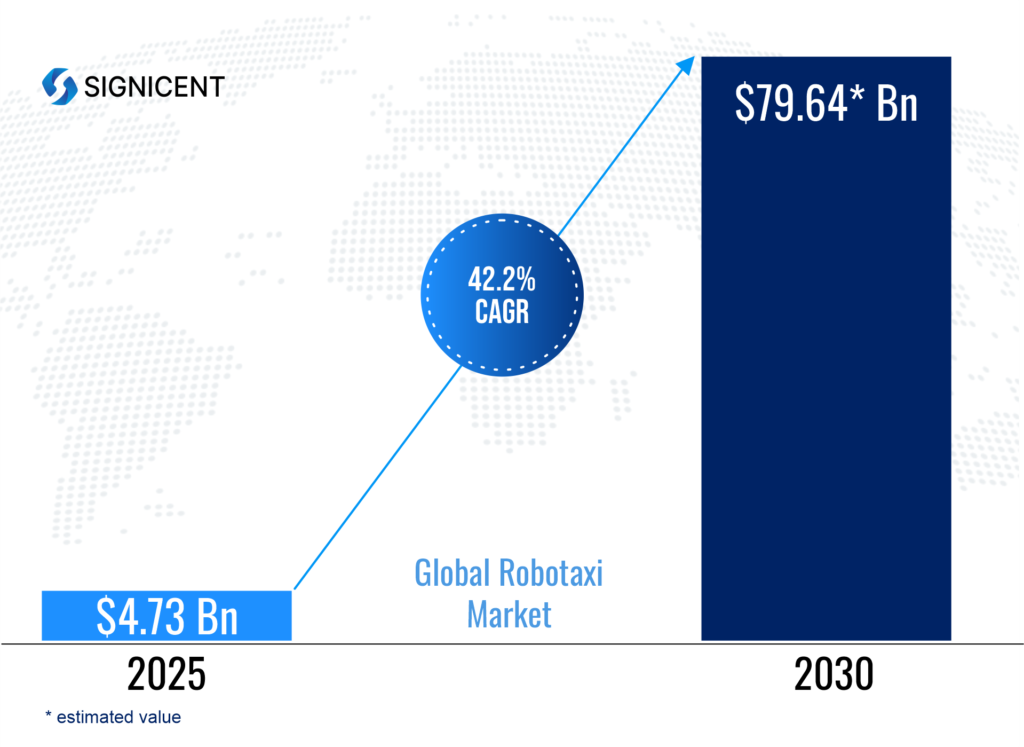
Key players in the Robo-Taxi industry
Signicent has worked closely with clients across the automotive and mobility sectors—especially in the fast-evolving landscape of AI-enabled robo-taxis. With autonomous vehicles redefining how we think about transportation, we recognize the growing importance of intelligent audio systems, real-time diagnostics, and predictive technologies.
From adaptive noise cancellation and AVAS (Acoustic Vehicle Alerting Systems) to AI-driven voice assistants and sound-based fault detection, our research services have helped companies bring these innovations to life. We’ve provided technology scouting for smart sensor integration, IP landscaping to navigate patent complexities, and benchmarking studies on next-gen infotainment and battery systems.
If you’re building the future of autonomous mobility, we’re here to support you. With tailored insights—from white space analysis to regulatory mapping—Signicent transforms cutting-edge ideas into safe, compliant, and market-ready robo-taxi solutions.
Conclusion
The shift from human-driven transport to AI-powered robo-taxis is no longer a futuristic fantasy; it’s becoming the blueprint for next-gen mobility. What once depended on reflexes and routines is now evolving through intelligent algorithms, sensor fusion, and real-time decision-making to meet the demands of a safer, smarter, and more sustainable world.
At Signicent, we’ve seen firsthand how innovators are embracing this shift by mapping autonomous technology, exploring innovative audio systems, and redesigning car experiences that put people and the environment first. There are still issues with infrastructure, legislation, and trust, but there is also a strong push to advance.
With accelerating R&D, bold pilots across cities, and increasing public acceptance, the road ahead is clear. Not only are robo-taxis on the horizon, but they are also redefining the concept of travel itself. It’s time for automakers, tech leaders, and cities to drive this change – with AI in the front seat.
FAQs
1. What exactly is a robo-taxi, and how does it work?
A robo-taxi is a self-driving vehicle that uses artificial intelligence, sensors, and real-time data to transport passengers—no human driver needed. It navigates roads, avoids traffic, and follows safety rules on its own.
2. Are robo-taxis really safe without a human behind the wheel?
Yes, they’re designed for safety. With AI constantly scanning surroundings using LiDAR, radar, and cameras, robo-taxis can react faster than humans and avoid distractions like fatigue or texting.
3. What role does audio technology play in robo-taxis?
Audio is a game-changer. Voice assistants allow hands-free ride control, spatial alerts notify passengers of nearby sirens or threats, and even diagnostics use sound to detect car issues before failure.
4. How are robo-taxis different from electric or hybrid cars?
While EVs focus on clean energy, robo-taxis go a step further—they drive themselves using AI, learn from every trip, adapt in real-time, and personalize the ride experience for each passenger.
5. Will robo-taxis replace human drivers completely?
Not overnight. While they’re expanding fast, human-driven vehicles will still coexist for a while. But in smart cities and high-demand zones, robo-taxis are set to dominate with 24/7 availability and lower costs.
6. How do robo-taxis impact the environment?
Most robo-taxis are electric, meaning zero emissions. Combined with AI’s route optimization and reduced idle time, they help cut traffic congestion and pollution significantly—great for urban sustainability goals.
